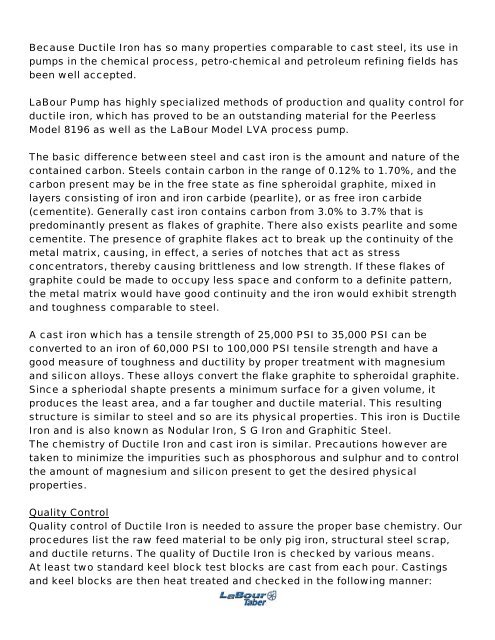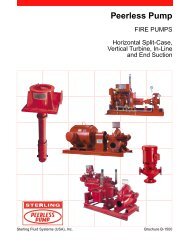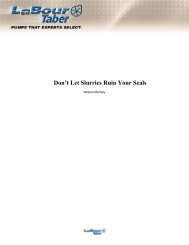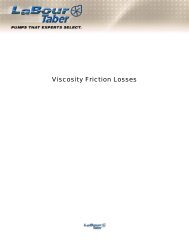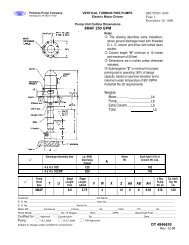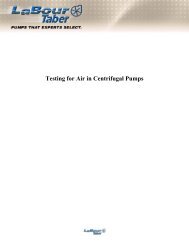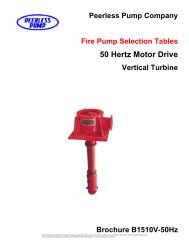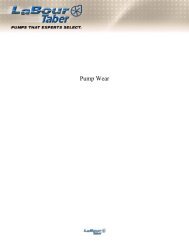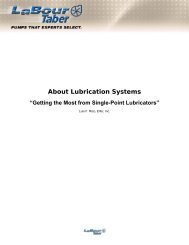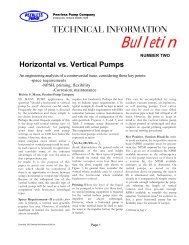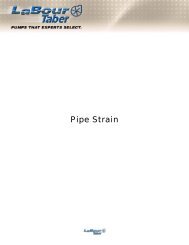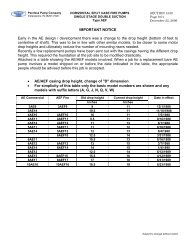Materials of Construction Ductile Iron (ASTM A436 ... - Peerless Pump
Materials of Construction Ductile Iron (ASTM A436 ... - Peerless Pump
Materials of Construction Ductile Iron (ASTM A436 ... - Peerless Pump
You also want an ePaper? Increase the reach of your titles
YUMPU automatically turns print PDFs into web optimized ePapers that Google loves.
Because <strong>Ductile</strong> <strong>Iron</strong> has so many properties comparable to cast steel, its use inpumps in the chemical process, petro-chemical and petroleum refining fields hasbeen well accepted.LaBour <strong>Pump</strong> has highly specialized methods <strong>of</strong> production and quality control forductile iron, which has proved to be an outstanding material for the <strong>Peerless</strong>Model 8196 as well as the LaBour Model LVA process pump.The basic difference between steel and cast iron is the amount and nature <strong>of</strong> thecontained carbon. Steels contain carbon in the range <strong>of</strong> 0.12% to 1.70%, and thecarbon present may be in the free state as fine spheroidal graphite, mixed inlayers consisting <strong>of</strong> iron and iron carbide (pearlite), or as free iron carbide(cementite). Generally cast iron contains carbon from 3.0% to 3.7% that ispredominantly present as flakes <strong>of</strong> graphite. There also exists pearlite and somecementite. The presence <strong>of</strong> graphite flakes act to break up the continuity <strong>of</strong> themetal matrix, causing, in effect, a series <strong>of</strong> notches that act as stressconcentrators, thereby causing brittleness and low strength. If these flakes <strong>of</strong>graphite could be made to occupy less space and conform to a definite pattern,the metal matrix would have good continuity and the iron would exhibit strengthand toughness comparable to steel.A cast iron which has a tensile strength <strong>of</strong> 25,000 PSI to 35,000 PSI can beconverted to an iron <strong>of</strong> 60,000 PSI to 100,000 PSI tensile strength and have agood measure <strong>of</strong> toughness and ductility by proper treatment with magnesiumand silicon alloys. These alloys convert the flake graphite to spheroidal graphite.Since a spheriodal shapte presents a minimum surface for a given volume, itproduces the least area, and a far tougher and ductile material. This resultingstructure is similar to steel and so are its physical properties. This iron is <strong>Ductile</strong><strong>Iron</strong> and is also known as Nodular <strong>Iron</strong>, S G <strong>Iron</strong> and Graphitic Steel.The chemistry <strong>of</strong> <strong>Ductile</strong> <strong>Iron</strong> and cast iron is similar. Precautions however aretaken to minimize the impurities such as phosphorous and sulphur and to controlthe amount <strong>of</strong> magnesium and silicon present to get the desired physicalproperties.Quality ControlQuality control <strong>of</strong> <strong>Ductile</strong> <strong>Iron</strong> is needed to assure the proper base chemistry. Ourprocedures list the raw feed material to be only pig iron, structural steel scrap,and ductile returns. The quality <strong>of</strong> <strong>Ductile</strong> <strong>Iron</strong> is checked by various means.At least two standard keel block test blocks are cast from each pour. Castingsand keel blocks are then heat treated and checked in the following manner:


